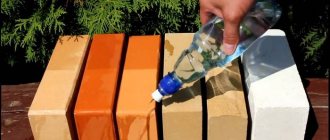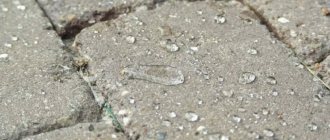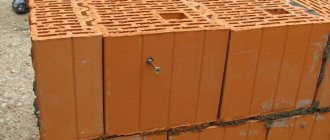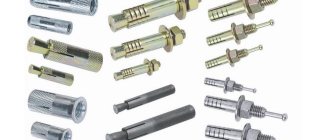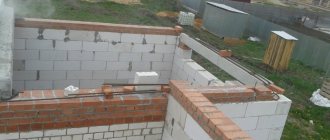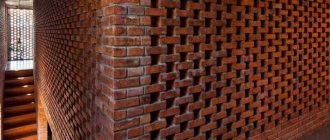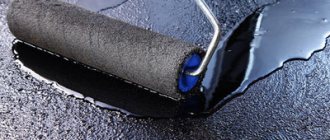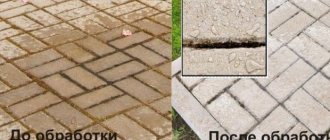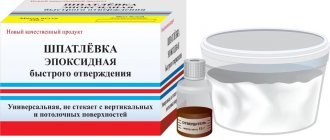Prolonged and direct contact with moisture actually destroys the stone. Naturally, brick and concrete, which are most often used in modern construction, also suffer from exposure to water. Penetrating inside, through several freezing/thawing cycles, it destroys the structure of the building material.
Water repellents help prevent such problems. Given their ever-increasing popularity, these highly effective formulations require detailed consideration.
What is hydrophobization and why is it needed?
The term “water repellent” refers to water-repellent compounds that prevent water from entering the brick. After application, the solutions form a moisture-proof film on the surface, preventing moisture from penetrating into pores and microcracks.
The compositions vary in performance and scope. In particular, they are universal or designed for processing a specific building material.
Professional builders claim that universal products are less effective. Therefore, it is better to give preference to profile compositions that are manufactured taking into account the technical characteristics of the material and other features.
The composition includes the following components:
- silane;
- siliconate;
- silicosan.
They create a waterproof layer that allows the facade to maintain its original properties regardless of external conditions.
How often should brick treatment be carried out?
To ensure the desired effect, the finished brickwork is processed. When applied to the surface, the water repellent penetrates deep into the material, and the depth of penetration depends on the density of the brick. The presence and uniformity of the coating can be determined by the change (by half a tone) in the shade of the wall.
Water repellents for bricks are made from aqueous solutions of water-resistant substances, which are sold in a liquid state. During the operation of the structure under active influence of water, the base of the mixture is gradually washed away. Taking this into account, it is recommended to carry out waterproofing treatment of bricks once every 10 years. When protecting walls made of poorly fired bricks, the frequency will have to be reduced to 5-6 years.
Application area
Water repellents have practically no restrictions on their use, therefore they are suitable for processing various building materials with a porous structure:
- Brick.
- Concrete.
- Ceramics.
- Clays.
Getting the facade wet can negatively affect not only the technical characteristics, but also the integrity of the building. The main task of hydrophobization is to create a protective layer. At the same time, the wall continues to “breathe”, therefore, condensation will not form.
Water repellents help improve the following characteristics:
- frost resistance;
- thermal conductivity;
- resistance to the appearance of pathogenic microflora;
- preventing the formation of efflorescence on facades.
Hydrophobization is relevant for new buildings and ancient buildings in need of restoration. In addition to the construction of residential buildings, moisture-proofing compounds are used in the construction of baths, saunas and other areas with high humidity levels, swimming pools, and are used in the production of gypsum boards .
Advantages of water-repellent solutions
Different types of water repellents for bricks have their own specific properties, which are important in specific conditions. All solutions in this category have the following advantages:
- a significant reduction in the water absorption of bricks and the wetness of its surface, even with vapor condensation;
- exclusion of capillary water suction from damp soil in the basement and foundation parts;
- increasing the resistance of brickwork to weathering, erosion, and temperature changes;
- a noticeable increase in the frost resistance of bricks and masonry mortar;
- preventing the formation of mold, fungi and the proliferation of dangerous microorganisms;
- eliminating the appearance of efflorescence on the wall surface.
It should be noted the versatility of water repellents. When processing brickwork, they are able to protect reinforcing and metal elements from corrosion, and wooden parts from rotting. Their composition is safe for human health.
Varieties
The modern building materials market offers three categories of water repellents, differing in composition:
- Alkyl siliconate is the most budget-friendly series that has been used since the times of the USSR .
- N-siloxane is an average price category with high water-repellent properties. After application, the surface does not change its original color.
- Silanxyloxane is the latest generation of deep penetration compounds. This is a rather expensive product, however, after application it creates a decorative effect.
Hydrophobization can be performed in two ways:
- Surface - the composition is applied to the facade, forming a moisture-proof film.
- Volumetric - the solution is introduced into the material at the production stage, filling the pores and preventing moisture from getting inside.
The best option: a combined technique. When a water-repellent mortar is added to the brick composition, and after the construction of the building, additional treatment of the facade is performed.
Types of protective compounds
There are several types of materials that can be used when hydrophobization treatment is required:
- Organosilicon group compounds (siloxane and silicone).
- Organofluorine substances for stones and other materials.
- Elements with cationic activity of the surface-active type.
- Salts that make up fatty acids.
- Salts of certain metals (copper, zirconium or aluminum).
The first group of materials has the longest service life. And it is precisely these substances that provide the maximum effect. Working with such compositions is also easy. Silicone-based water repellent for marble is widely used.
Hydrophobizers of the organosilicon group can also be divided into several groups:
- Hydroxyl-containing siloxanes.
- Hydrogen-containing siloxanes.
- Alkoxysilanes.
- Potassium alkyl siliconates.
Potassium alkyl siliconates require very careful handling, even if only water is added to them. Compositions are distributed in the form of high-concentration alkaline solutions
On video: review of Neograd water repellent.
Which water repellent to choose
The compositions of this series are produced by domestic and Western companies; accordingly, they differ not only in price, but also in technical properties. The range of products on the Russian market is very diverse.
Inexperienced consumers may have difficulty choosing the right products. Here is a list of the best manufacturers that are in consistently high demand among builders and finishers.
- Tiprom. A series of water repellents with waterproof and antiseptic effects. The manufacturer offers three groups of products that differ in the level of protection.
- Bionic MBO . This is a water-based product with the addition of polymer fluorocarbons. It does not contain active chemical components, so the material is absolutely safe from an environmental point of view. The solution can be applied to facades made of brick, porcelain stoneware and ceramic tiles.
- NEOMID H20 STOP . A domestic product that protects against damp environments, prevents the appearance of dirt on building facades and corrosive changes, and helps get rid of efflorescence. It is made on the basis of silicon and organic compounds, safe for human health and pets.
- DALI HYDROSTOP. A universal solution used for treating facades, foundations, and interior spaces. The composition is made on a mineral basis, suitable for artificial stone, brick and concrete, increases the frost resistance of the base.
- CAPAROL DISBOXAN 450 . The concentrated substance is diluted with water in a ratio of 1:4 . Suitable for brick and concrete bases, used for treating surfaces plastered with mineral compounds. After application, frost resistance and antiseptic properties increase. Has a slight odor.
- HYDROREP . A highly effective product that provides reliable protection of the facade from the negative influence of a humid environment. The solution does not require preparation or dilution and is ready for use immediately after purchase. It belongs to the category of toxic substances; if it enters the respiratory tract, it can cause harm to the lungs.
- GOOD MASTER. Deep penetration composition that fills pores to a depth of 3 cm . After application, an indelible protective film is formed, the color of the base does not change.
In addition, the compositions produced by Penta and REMMERS performed well.
Basic criteria for choosing waterproofing liquids
To choose a specific waterproofing liquid, you should decide on the following questions:
- what surfaces will be processed (material, wet or dry base);
- the level of positive properties that it is desirable to achieve after treatment;
- versatility of use;
- manufacturer or brand.
Universal water repellents Aquasil, Ceresit and Optimist
The versatility of application is relevant when it is necessary to treat different surfaces and provide them with identical hydrophobization properties. For these purposes, the domestically produced water repellent Aquasil is suitable, which is produced in concentrated ready-made solutions and has an affordable price. It is suitable for all materials used for roofing or foundations; it reduces the water absorption of concrete, foam concrete, natural and artificial stones by 10-15, and brick by 15-40 times. At the same time, the decorative qualities of the processed materials do not suffer. The warranty without additional repairs is 10 years, but in some cases, updating the coating may not be necessary for up to 30 years of operation.
Optimist water repellents are suitable for treating a variety of surfaces
Helpful advice! Always follow the exact recipe for diluting the water repellent. An error in concentration can lead to the formation of streaks and efflorescence.
The water repellent Ceresit is, as a rule, chosen because the brand is famous, which guarantees the quality of building mixtures. In this case, this is also legal. The manufacturer has a series of several water-repellent impregnations with universal action, each of which enhances one of the characteristics. The most popular is Ceresit CT 13 for highly absorbent surfaces, except horizontal ones (paving slabs). It perfectly isolates internal small cracks up to 0.2 mm and provides an 8-12 year warranty period, during which re-impregnation is not required.
To treat various surfaces of building structures, we use the water repellent Optimist. It is not as rich in additional options as Aquasil and Ceresit, but it copes brilliantly with the task of protecting against water and dirt. In addition, the product line includes special formulations for individual processing of materials, for example, stone, wood. To protect against mold, to ensure plasticization, frost resistance of concrete, etc., special products are produced. The liquid is completely ready for use.
Application rules
Protecting facades from moisture is not a technologically complex process, so the work can be done on your own, without the involvement of specialized specialists.
The following steps are followed:
- The base is prepared and cleaned of dirt and dust. Visible defects: cracks and chips, it is better to eliminate them.
- The water repellent is applied evenly over the entire surface, leaving no untreated space. For application, you can use rollers, brushes or sprayers.
- After completion of the work, the surface is covered until the composition dries completely (about 24 hours ). If no precipitation is expected within the next 24 hours, this stage can be neglected.
It should be noted that treatments are carried out only at positive temperatures. The solution is applied until the surface stops absorbing moisture. You can check the water-repellent properties like this: after the surface dries, a drop of water that gets on it will roll down.
PPU shells for reliable thermal insulation of pipelines
PPU shells are the most effective thermal insulation for underground and above-ground pipes!
Advantages:
- moisture resistance
- very low thermal conductivity – 0.029
- wide range of external coatings
- ease of installation
- high maintainability
- temperature range of use from -200 to +140 C°
- service life - over 50 years!
Prices are lower than competitors!
Prices for building materials, thermal insulation and insulation have already increased, on average, by 30-40% since the beginning of 2015. What to do? Is it possible to buy cheap thermal insulation somewhere else?
This is true. If you want to have a dry basement in your home, then only penetrating waterproofing can stop any leaks once and for all. Even if the water rushes...
